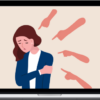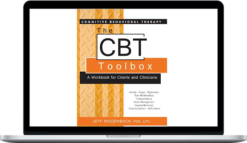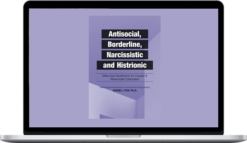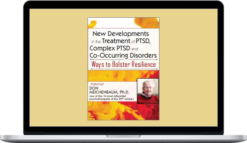NICABM – Strategies To Help Clients Navigate Rupture And Build Skills Of Repair
$197.00 $89.00
»Delivery: Within 21 days
Description
NICABM – Strategies To Help Clients Navigate Rupture And Build Skills Of Repair
Help Clients Overcome the #1 Threat to Their Relationships
Strategies to Navigate Rupture and Build Skills of Repair
For many clients, the number one threat to their relationships is not knowing how to respond when a rupture (inevitably) happens.
That’s because too often, clients lack even basic skills for effective repair. And when relationship ruptures pile up without repair, they can spark mistrust, bitterness, and resentment that takes years to overcome (or spell the end of the relationship).
So to foster a client’s skills of repair, we need to:
- Understand how the brain and nervous system can influence the way your client perceives rupture
- Apply strategies to ease the unconscious defenses that can complicate the repair process
- Tailor the process of repair to complement your client’s attachment style
- Develop a roadmap to repair that can help your client heal ruptures in their relationships
That’s just some of what we’ll be getting into in this Strategies To Help Clients Navigate Rupture And Build Skills Of Repair course:
Strategies to Help Clients Navigate Rupture and Build Skills of Repair
How to Tailor Your Repair Work to Complement Your Client’s Attachment Style
Ruth Lanius, MD, PhD Pat Ogden, PhD Deany Laliotis, LICSW
Ellyn Bader, PhD Russell Kolts, PhD George Faller, MS, LMFT
- Specific Psychoeducation to Help Clients Understand How Insecure Attachment Can Lead to Struggles with Repair
- How Clients with an Anxious Attachment Style Often Approach Rupture (and Strategies to Help Them Develop a Healthier Response)
- How to Help Clients Who Are Afraid of Rupture Deepen Their Relationships with Others
- How to Help Clients with Disorganized Attachment Learn Skills of Repair within the Therapeutic Relationship
How to Work with a Trauma That Distorts a Client’s Perception of Rupture (and Prevents Repair)
Pat Ogden, PhD Frank Anderson, MD
Juliane Taylor Shore, LPC, LMFT, SEP Dennis Tirch, PhD
- How Trauma Can Change the Brain and Shape a Client’s Perception of Rupture
- Two Key Questions That Can Help Direct Your Work with Repair in the Context of Trauma
- A Five-Step Roadmap to Help Clients Who’ve Experienced Trauma Approach Repair
- How to Help Clients Change the Non-Verbal Cues That Can Complicate the Process of Repairing Ruptures
- A Three-Step Process to Work with Ruptures That Are Rooted in Betrayal
Why the Nervous System’s Response Can Complicate Repair
Ruth Lanius, MD, PhD Janina Fisher, PhD Russell Kolts, PhD
Chris Willard, PsyD Ray Rodriguez, LCSW-R George Faller, MS, LMFT
- What Happens in the Brain and Nervous System When a Rupture Occurs
- How to Help Clients Tune into Unconscious Triggers That Can Lead to Ruptures
- A Two-Step Approach to Help Shift a Client’s Threat Response to Rupture
- A Polyvagal-Informed Approach to Helping Clients Repair Ruptures
- Strategies to Work with Clients Who Respond to Ruptures by Fighting, Submitting, or Freezing
How to Work with Clients Who Think Repair Is Not Possible
Juliane Taylor Shore, LPC, LMFT, SEP Chris Willard, PsyD Ron Siegel, PsyD
Ray Rodriguez, LCSW-R Pat Ogden, PhD Dennis Tirch, PhD
- Two Factors to Help Clients Consider Whether a Relationship Is Beyond Repair
- How to Work with Clients Who Are Considering Ending a Relationship Following a Rupture
- Strategies to Help Clients Find Peace and Closure After a Relationship Ends
- How to Help Clients Set Boundaries Without Infringing On Their Autonomy
Expert Strategies for Navigating Ruptures in the Therapeutic Relationship
Zindel Segal, PhD Raymond Rodriguez, LCSW-R
Usha Tummala-Narra, PhD Christine Padesky, PhD Kelly Wilson, PhD
- Three Subtle Signs That a Rupture Has Occurred within the Therapeutic Relationship
- A Five-Step Checklist to Help You Address Ruptures When You Recognize Them
- How to Address a Rupture That Was Initially Missed or Overlooked
- Research That Highlights the Relationship Between Repaired Ruptures and a Client’s Sudden Gains
- One Critical Piece of Repair Work That’s Often Missing In Clinical Training
How to Help Clients Overcome Patterns of Conflict Avoidance
Usha Tummala-Narra, PhD Christine Padesky, PhD Lynn Lyons, LICSW
Zindel Segal, PhD George Faller, MS Deany Laliotis, LICSW
- When “I’m Sorry” Isn’t Enough: How to Work with Clients Who Rely on Basic Apologies as a Form of Conflict Avoidance
- A Four-Step Process to Help Clients Build Trust While Repairing Ruptures
- Specific Language to Help Clients Build Skills of Repair
- Cultural Factors That Can Fuel Patterns of Avoidance (and How to Address Them)
- Nine Behavioral Patterns That Can Help Predict Rupture (and How to Help Clients Confront Their Specific Pattern)
Strategies to Help Clients Who Struggle with Attunement
Janina Fisher, PhD Eboni Webb, PsyD Usha Tummala-Narra, PhD
Chris Willard, PsyD Ellyn Bader, PhD Raymond Rodriguez, LCSW-R
- How to Work with Attachment Wounds That Impair a Client’s Ability to Attune with Others
- How to Ease Feelings of Shame and Self-Blame That Often Stem from a Client’s Struggle to Attune
- A Three-Step Process to Help Clients Who Struggle with Attunement
- How Mental Health Disorders (Like Depression and Borderline Personality Disorder) Can Impact a Client’s Ability to Attune with Others
How to Help Clients Set Boundaries in Ruptured Relationships
Michael Yapko, PhD Lynn Lyons, LICSW
Juliane Taylor Shore, LPC, LMFT, SEP Deany Laliotis, LICSW
- A Six-Step Process to Help Clients Learn to Set Boundaries
- Specific Metaphors That Can Help Clients Develop a Wider Range of Boundaries
- Strategies to Help Clients Whose First Instinct Is to Cut People Out of Their Lives
- How to Help Clients Differentiate Between Healthy and Unhealthy Boundaries
- How to Work with Clients Who Hold an “All or Nothing” View of Repair
Strategies to Help Couples Work Toward Effective Repair
Terry Real, MSW, LICSW Ellyn Bader, PhD Elliott Connie, MA, LPC
George Faller, MS, LMFT Joan Borysenko, PhD Chris Willard, PsyD
Juliane Taylor Shore, LPC, LMFT, SEP Michael Yapko, PhD Dennis Tirch, PhD
- How to Help Partners Make Fewer Unilateral Decisions and Work as a Team
- A Simple Reframe of Ruptures That Can Help Couples Work Toward Compromise
- One Insidious Behavioral Pattern That Can Lead to Ruptures (and How to Address It)
- How to Determine When It Might Be the “Wrong Time” to Pursue Repair
About NICABM
We proudly provide continuing education for practitioners who are dedicated to being the best in their craft. Our goal is to develop programs that connect you with the top experts and the latest strategies in the field, to help you achieve better outcomes, more quickly with each of your clients.
More courses from the same author: NICABM
Delivery Policy
When will I receive my course?
You will receive a link to download your course immediately or within 1 to 21 days. It depends on the product you buy, so please read the short description of the product carefully before making a purchase.
How is my course delivered?
We share courses through Google Drive, so once your order is complete, you'll receive an invitation to view the course in your email.
To avoid any delay in delivery, please provide a Google mail and enter your email address correctly in the Checkout Page.
In case you submit a wrong email address, please contact us to resend the course to the correct email.
How do I check status of my order?
Please log in to HealingCourse account then go to Order Page. You will find all your orders includes number, date, status and total price.
If the status is Processing: Your course is being uploaded. Please be patient and wait for us to complete your order. If your order has multiple courses and one of them has not been updated with the download link, the status of the order is also Processing.
If the status is Completed: Your course is ready for immediate download. Click "VIEW" to view details and download the course.
Where can I find my course?
Once your order is complete, a link to download the course will automatically be sent to your email.
You can also get the download link by logging into your HealingCourse account then going to Downloads Page.
Related products
Total sold: 1








